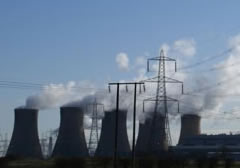|
|
 |
| |
 |
|
 |
| |
| |
|
|
|
|
| About Solar Energy |
|
|
|
 |
|
|
|
| |
Fossil Fuels are the most widely-used means of generating electricity, and have been for some time. However, fossil fuels, as we have discovered, are a limited and non-renewable resource. Estimates have determined that fossil fuel reserves may well run dry by as early as 2050. Not only are fossil fuel reserves dwindling, but byproducts and emissions from burning fossil fuels are harmful to the environment, and have been associated with global warming theory. |
|
 |
|
| |
|
|
|
|
| |
Energy from the sun is caused from thermonuclear expolosions deep within the sun. These explosions fuse atoms of hydrogen into atoms of helium. A tremendous amount of energy is released during the thermonuclear reaction and the sun releases that energy as radiation. This radiation travels through space at the speed of light, and solar panels can make practical use of it. Our sun generates an enourmous amount of energy, and potentially, had we the technology to harvest that sunlight with solar arrays across the solar system, we could harvest huge amounts of energy. |
|
 |
|
| |
|
|
|
|
| |
Solar panels collect solar radiation from the sun and actively convert that energy to electricity. The solar cells on these solar panels make use of the extremely small fraction of the sun's energy that passes through earth's atmosphere and strikes the cells on the solar collector. The efficiency of these solar panels, and the resultant energy produced is dependant on many climatic, geographic, and weather-related factors. Arid climates are ideal for solar panels, and they will produce more energy in areas where they are exposed to direct sunlight under clear skies. But even at optimal efficiency, solar panels only convert a small percentage of the energy that strikes it into usable energy. The efficiency factors is in the teens for most solar cells. Advanced solar cells, like those used on the Voyager spacecraft, have much higher efficiency ratings, but are much too expensive to produce en masse for general purposes. |
|
 |
|
| |
|
|
|
|
| |
|
|
|
|
|
|
 |
|
 |
|
|
 |
|